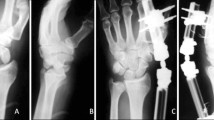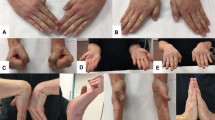Abstract
Introduction
A transscaphoid and transtriquetral perilunate fracture dislocation is fairly rare among the known cases of perilunate fracture dislocations, and the details of the initial treatment and outcome of this injury have never been reported.
Materials and methods
A 21-year-old, right-handed man presented with fractures at the proximal third of the scaphoid and at the mid-body of the triquetrum with an associated dorsal perilunate dislocation after a fall onto his outstretched hand. Under general anesthesia, closed reduction was attempted with 3 kg of traction applied by means of finger traps. After anatomical reduction was achieved, percutaneous fixation was applied to both the triquetrum and scaphoid using cannulated screws. A short arm thumb spica splint was applied for 2 weeks, and part-time splinting was continued for an additional 3 weeks. The patient subsequently underwent 3 months of intensive range-of-motion and muscle-strengthening exercises.
Results
At the final follow-up examination 68 months after the initial operation, the arc of motion of the right wrist, 150°(extension plus flexion arc), and grip strength, 41 kg, were 94% and 103% of the values for the unaffected wrist, respectively. Radiographs showed a bony union of the scaphoid and triquetrum, and no sign of avascular necrosis in the proximal scaphoid fragment, as well as other carpi. No midcarpal or radiocarpal degenerative arthritis was observed, and the normal carpal bone relationships were still maintained, with a scapholunate angle of 48°and a scapholunate gap of 2 mm.
Conclusion
We recommend closed reduction and percutaneous screw fixation of the scaphoid, as well as the triquetrum in this case, to minimize the interruption of the blood supply to the carpus and also to obtain rigid fixation during the procedure




Similar content being viewed by others
References
Gellman H, Schwartz SD, Botte MJ, Feiwell L (1988) Late treatment of a dorsal transscaphoid, transtriquetral perilunate wrist dislocation with avascular changes of the lunate. Clin Orthop 237:196–203
Green DP, O'Brien ET (1978) Open reduction of carpal dislocations: indications and operative techniques. J Hand Surg 3:250–265
Green DP, O'Brien ET (1980) Classification and management of carpal dislocations. Clin Orthop 149:55–72
Herzberg G, Forissier D (2002) Acute dorsal trans-scaphoid perilunate fracture-dislocations: medium-term results. J Hand Surg Br 27:498–502
Herzberg G, Comtet JJ, Linscheid RL, Amadio PC, Cooney WP, Stalder J (1993) Perilunate dislocations and fracture-dislocations: a multicenter study. J Hand Surg Am 18:768–779
Hildebrand KA, Ross DC, Patterson SD, Roth JH, MacDermid JC, King GJ (2000) Dorsal perilunate dislocations and fracture-dislocations: questionnaire, clinical, and radiographic evaluation. J Hand Surg Am 25:1069–1079
Johnson RP (1980) The acutely injured wrist and its residuals. Clin Orthop 149:33–44
Lichtman DM, Martin RA (1988) Introduction to the carpal instabilities. In: Lichtman DM (ed) The wrist and its disorders. WB Saunders, Philadelphia, pp 244–250
Mayfield JK, Johnson RP, Kilcoyne RK (1980) Carpal dislocations: pathomechanics and progressive perilunar instability. J Hand Surg 5:226–241
Melone CP Jr, Murphy MS, Raskin KB (2000) Perilunate injuries. Repair by dual dorsal and volar approaches. Hand Clin 16:439–448
Wozasek GE, Moser K-D (1991) Percutaneous screw fixation for fractures of the scaphoid. J Bone Joint Surg Br 73:138–142
Acknowledgements
We thank Edward Diao, MD, San Francisco, CA, USA, for his constant interest and guidance in this report. Read in part at the 8th Congress of the International Federation of Societies for Surgery of the Hand, June 10–14, 2001, held in Istanbul, Turkey.
Author information
Authors and Affiliations
Corresponding author
Rights and permissions
About this article
Cite this article
Soejima, O., Iida, H. & Naito, M. Transscaphoid-transtriquetral perilunate fracture dislocation: report of a case and review of the literature. Arch Orthop Trauma Surg 123, 305–307 (2003). https://doi.org/10.1007/s00402-003-0521-0
Received:
Published:
Issue Date:
DOI: https://doi.org/10.1007/s00402-003-0521-0




